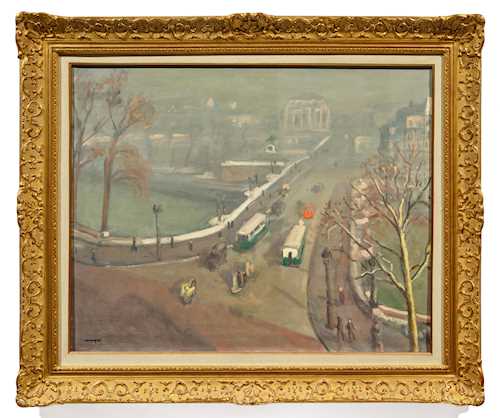
Lot 3228 - A209 Impressionist & Modern Art - Friday, 21. June 2024, 05.00 PM
ALBERT MARQUET
(Bordeaux 1875–1947 Paris)
Pont Neuf, brume d'automne. Circa 1937.
Oil on canvas.
Signed lower left: marquet.
65 × 81 cm.
Certificate:
Provenance:
- With Galerie de la Présidence, Paris (label verso).
- Private collection, West Switzerland, acquired in April 2005 from the above gallery and thence by descent.
The bright green of two trams and the red light of an automobile are the only two color accents in this large-format painting by Albert Marquet and inevitably draw the eye to this scene.
The last Paris tram ran on March 15, 1937. The tram had experienced a real boom due to the World Exhibition in Paris around 1900, and the initially horse-drawn and later mechanically-driven carriages had been replaced by electrically powered vehicles. The year 1925 marked both its high point, with around 720 million passengers transported, and the beginning of the sytem's decline. People increasingly switched to cars and buses.
It remains to be seen whether the work, which was created around 1937, is a form of homage to the last Parisian trams.
Both the subject and its execution are characteristic of Marquet, who, as a close observer, translates reality poetically, using economical means and a fluid visual language, while limiting himself to a few essential accents, in terms of both theme and color.
His wife Marcelle said of him that he was horrified by anything that had the appearance of something definite and rigid. Hence Marquet's fascination with the mobile element of water, which he repeatedly depicts in and around Paris, in Normandy, in Alger and also in Switzerland.
But the subjects of cargo ships and cranes in the ports or trams and cars, as here, also correspond to this statement. Because technology and vehicles stand for progress and movement; in both the explicit and figurative sense they are the opposite of fixed and unchangeable. Even the bridge can be interpreted as a symbol of moving from here to there.
It is also fitting that Marquet often immerses his scenes in rising smoke from the barges' chimneys, in snow (there are similar paintings of the Pont Neuf in the snow), or in fog – as in this case – which makes everything appear in the diffuse light of a Parisian autumn day.
Boundaries and clear contours blur. The many nuances of gray and the fluidity of his imagery combine with the impermanence of weather and time.
The last Paris tram ran on March 15, 1937. The tram had experienced a real boom due to the World Exhibition in Paris around 1900, and the initially horse-drawn and later mechanically-driven carriages had been replaced by electrically powered vehicles. The year 1925 marked both its high point, with around 720 million passengers transported, and the beginning of the sytem's decline. People increasingly switched to cars and buses.
It remains to be seen whether the work, which was created around 1937, is a form of homage to the last Parisian trams.
Both the subject and its execution are characteristic of Marquet, who, as a close observer, translates reality poetically, using economical means and a fluid visual language, while limiting himself to a few essential accents, in terms of both theme and color.
His wife Marcelle said of him that he was horrified by anything that had the appearance of something definite and rigid. Hence Marquet's fascination with the mobile element of water, which he repeatedly depicts in and around Paris, in Normandy, in Alger and also in Switzerland.
But the subjects of cargo ships and cranes in the ports or trams and cars, as here, also correspond to this statement. Because technology and vehicles stand for progress and movement; in both the explicit and figurative sense they are the opposite of fixed and unchangeable. Even the bridge can be interpreted as a symbol of moving from here to there.
It is also fitting that Marquet often immerses his scenes in rising smoke from the barges' chimneys, in snow (there are similar paintings of the Pont Neuf in the snow), or in fog – as in this case – which makes everything appear in the diffuse light of a Parisian autumn day.
Boundaries and clear contours blur. The many nuances of gray and the fluidity of his imagery combine with the impermanence of weather and time.
CHF 100 000 / 150 000 | (€ 103 090 / 154 640)
Sold for CHF 112 500 (including buyer’s premium)
All information is subject to change.


